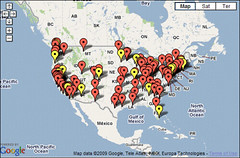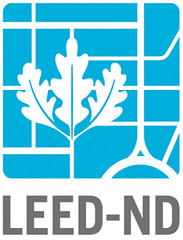The year's top smart growth stories

Posted December 29, 2009 at 1:34PM
Yesterday I posted my favorite blog entries of 2009. Today I’ll give you my picks for the year’s top ten smart growth stories and, in some cases, disappointing non-stories. It’s admittedly a very subjective and idiosyncratic list, comprising only the happenings that seemed most significant to me:
- (10) Despite robust ridership, transit service and quality continued to decline. As the year began, public transportation ridership had risen to its highest level in decades. Nevertheless, at the same time as the government poured a trillion dollars or more into other parts of the
 American economy to counter the recession, the nation’s cash-strapped transit systems were forced to make service cutbacks, delay repairs and improvements, and raise fares. Transportation for America’s interactive map, “The United States of Transit Cutbacks,” illustrates this sorry story.
American economy to counter the recession, the nation’s cash-strapped transit systems were forced to make service cutbacks, delay repairs and improvements, and raise fares. Transportation for America’s interactive map, “The United States of Transit Cutbacks,” illustrates this sorry story. - (9) Smart growth and sustainable communities were largely missing from the federal stimulus. With a misguided focus on “shovel-ready” projects that favored new construction, federal stimulus legislation gave not a penny to transit agencies desperate to meet operating and maintenance expenses and, with some exceptions, the stimulus also did little to support urban revitalization or suburban retrofits.
- (8) Exciting developments in GIS- and web-based technology advanced walkability and smart communities. The sophisticated technology that first became widely available to the public several years ago with the still-amazing Google Earth ripened and spawned a plethora of user-friendly applications. These included, for example, the continued evolution of Walk Score, CNT’s (and ULI’s) affordability and carbon mapping, Criterion’s carbon footprint mapping, and NRDC’s own Picturing Smart Growth, developed with the assistance of Urban Advantage.
- (7) Local agriculture emerged as a component of green development.
 It’s been building for a few years, but now everyone is talking about agricultural suburbs, urban farms, farmers’ markets that emphasize local sources, and the like. Personally, I prefer a nuanced approach, since local isn’t always better for the environment, and scattering farming around potentially urban land can expand sprawl, with a host of bad consequences. We must be judicious. But I do like farmers’ markets and small-scaled gardens that fit into city neighborhoods.
It’s been building for a few years, but now everyone is talking about agricultural suburbs, urban farms, farmers’ markets that emphasize local sources, and the like. Personally, I prefer a nuanced approach, since local isn’t always better for the environment, and scattering farming around potentially urban land can expand sprawl, with a host of bad consequences. We must be judicious. But I do like farmers’ markets and small-scaled gardens that fit into city neighborhoods. - (6) Congress, nonprofits and other parties geared up for reauthorization of federal transportation law. In theory, federal omnibus transportation legislation (which funds highway maintenance and construction, transit construction, cycling facilities, and other infrastructure) expired this year. In reality, the old law is being kept alive with sequential short-term extensions, and will probably be replaced in the next session of Congress. Organizations like Smart Growth America (which begat Transportation for America), NRDC, and even CNU see a once-in-a-generation opportunity to green the law as never before and have begun pouring enormous resources into the effort. Private foundations have shifted funding out of other aspects of smart growth in order to fund related background work. It’s an enormous undertaking that does not come without cost. Let’s hope it pays off.
- (5) Land use solutions continued to get short shrift in climate discussions that matter. Despite the smart growth and development community’s best efforts (e.g., the carbon mapping mentioned above, Growing Cooler, Mike Mehaffy’s research, CCAP’s terrific report, California’s SB 375), land use strategies that could make a big difference continued to be ignored or discounted by the climate establishment. You won’t find very much about smart growth in pending federal climate bills, the implementation so far of California’s Global Warming Solutions Act (AB 32), or the recent National Academy of Sciences report that has been deservedly rebutted by Reid Ewing, for example. And that’s a shame.
- (4) The Obama administration stepped up for sustainable communities.
 You have to go all the way back to the Nixon administration, really, to find much in the way of top-level federal leadership for smart development and sustainable communities (and that legislation didn’t pass). Until now, that is, with the secretaries of Transportation and Housing and Urban Development having become eloquent spokespeople for the cause (along with EPA’s smart growth office, of course), and even the President himself getting in on it. It’s manifested in numerous ways, potentially the most important being the federal partnership for sustainability. This could become a big deal, and I’d love nothing more than enough accomplishment to boost this story to number one on next year’s list.
You have to go all the way back to the Nixon administration, really, to find much in the way of top-level federal leadership for smart development and sustainable communities (and that legislation didn’t pass). Until now, that is, with the secretaries of Transportation and Housing and Urban Development having become eloquent spokespeople for the cause (along with EPA’s smart growth office, of course), and even the President himself getting in on it. It’s manifested in numerous ways, potentially the most important being the federal partnership for sustainability. This could become a big deal, and I’d love nothing more than enough accomplishment to boost this story to number one on next year’s list. - (3) Street design became a major smart-growth issue. If you’re an insider, you know that it really hasn’t come out of nowhere, but the closely related causes of “complete streets” to accommodate additional users beyond motor vehicles, and street connectivity to promote walkability and community, have matured immensely. Just in this blog alone, I reported stories this year from New York City, Virginia, St. Louis, and Texas involving improvements in street design rules. A story in the December New Urban News reminds us that all is not won, however, since the keepers of the International Fire Code recently reaffirmed their commitment to wide streets.
- (2) LEED-ND was completed and approved for implementation. How long LEED for Neighborhood Development has been in the making depends on when you start the clock. (For me personally, it’s now over seven years.) But after drafts and comments and revisions, many more drafts and comments and revisions, the implementation of a pilot program to inform the program’s development, and lots of argument and negotiation along the way, the system was finally completed and approved by all the relevant organizations, including NRDC and Smart Growth America.
 I wish it were stronger, to be honest, but for the first time we now have a thoroughly debated national code delineating the requisites of smart, green development, and a system ready to reward those that meet it. (Newly planned smart, green developments can’t apply for a certification yet, though, and you might want to ask the US Green Building Council about that.)
I wish it were stronger, to be honest, but for the first time we now have a thoroughly debated national code delineating the requisites of smart, green development, and a system ready to reward those that meet it. (Newly planned smart, green developments can’t apply for a certification yet, though, and you might want to ask the US Green Building Council about that.) - (1) The recession hurt smart development somewhat, but sent sprawl into a virtual coma. Fewer smart growth developments are being built, and some have been abandoned. Revitalization has slowed. But some great projects have continued and, meanwhile, sprawl as we have known it has almost ground to a halt. The strong market preference for walkable neighborhoods in more convenient locations has never been more pronounced, and the best analysts in the business are predicting that the trend is here to stay.
So: all in all, we had a mixture of good, disappointing, and great news for smart growth and sustainability in 2009. Taking a long view that considers where this issue was fifteen or even ten years ago, I remain very optimistic. May 2010 bring the best of news for all who read this blog and for the people and causes we care about.